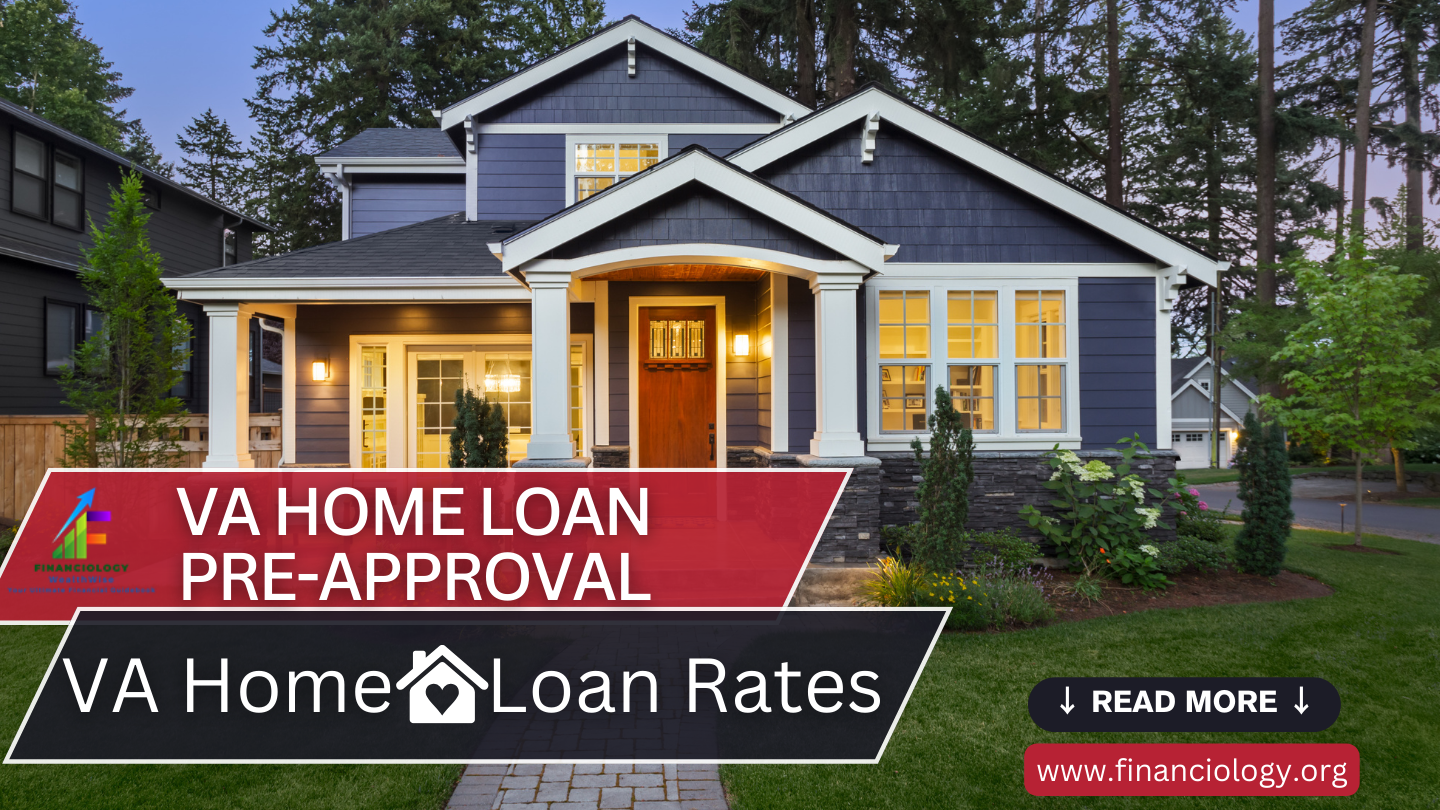How to Apply for a VA Home Loan? | Financiology
9 min read
How to Apply for a VA Home Loan?
A Step-by-Step Guide:
The U.S. Department of Veterans Affairs: Learn how to navigate the process of applying for a VA home loan with our comprehensive guide. From eligibility requirements to documentation, we’ve got you covered.
When applying for a VA home loan, understanding the process is key to a smooth experience. Here’s a step-by-step guide to help you through:
- Determine Eligibility: Before applying, ensure you meet the eligibility requirements for a VA home loan. Typically, veterans, active-duty service members, National Guard members, reservists, and certain spouses may qualify.
- Obtain a Certificate of Eligibility (COE): The COE proves your eligibility for a VA home loan. You can apply online through the VA’s eBenefits portal, or your lender can assist you in obtaining it.
- Find a VA-Approved Lender: Not all lenders offer VA loans, so it’s essential to find one that is approved by the Department of Veterans Affairs. Research lenders and compare their terms and rates to find the best fit for your needs.
- Prequalification and Preapproval: Getting prequalified or preapproved for a VA loan can give you a clear understanding of your budget and strengthen your position as a buyer. It involves submitting financial documents to the lender for review.
- Gather Necessary Documents: Be prepared to provide documentation such as proof of income, employment history, credit history, and information on any debts or assets. Organizing these documents ahead of time can streamline the application process.
- Submit Your Application: Once you’ve chosen a lender and gathered your documents, it’s time to submit your application for a VA home loan. Your lender will guide you through the paperwork and requirements.
- Underwriting and Approval: After submitting your application, the lender will review your financial information and conduct a credit check. If everything checks out, they will approve your loan application, subject to a property appraisal.
- Home Search and Offer: With your loan approval in hand, you can start searching for your dream home. Work with a real estate agent to find properties that meet your criteria and submit an offer.
- Loan Closing: Once your offer is accepted, you’ll enter the closing process. This involves signing the necessary legal documents, paying closing costs, and finalizing the purchase of your home.
- Enjoy Your New Home: Congratulations! You’ve successfully applied for a VA home loan and purchased your new home. Now it’s time to settle in and enjoy the benefits of homeownership.
By following these steps and working with experienced professionals, you can navigate the process of applying for a VA home loan with confidence. Whether you’re a veteran, active-duty service member, or eligible spouse, a VA loan can help you achieve your homeownership goals.
Understanding the Current Landscape of VA Home Loan Rates

Meta Description: Stay informed about the latest trends in VA home loan rates to make confident decisions about your mortgage. Explore factors influencing rates and tips for securing the best deal.
When it comes to VA home loan rates, staying updated on current trends is crucial for prospective homebuyers. Here’s what you need to know about the current landscape:
- Market Influences: VA home loan rates are influenced by various factors, including the overall economy, inflation rates, and monetary policy set by the Federal Reserve. Changes in these economic indicators can impact mortgage rates.
- Historical Context: Understanding historical trends in VA home loan rates can provide valuable insight into the current market. While rates fluctuate over time, they have remained historically low in recent years, making it an opportune time to consider buying or refinancing.
- Current Rates: As of April 20, 2024, VA home loan rates remain competitive, offering favorable terms for eligible borrowers. It’s advisable to monitor rate updates regularly to capitalize on favorable market conditions.
- Factors Affecting Individual Rates: While the overall market influences VA home loan rates, individual borrowers’ rates may vary based on factors such as credit score, debt-to-income ratio, loan amount, and loan term. Maintaining a good credit score and reducing debt can help secure lower interest rates.
- Locking in Rates: When applying for a VA home loan, borrowers have the option to “lock in” their interest rate for a specified period, typically between 30 and 60 days. This protects against potential rate increases during the homebuying process, providing peace of mind.
- Comparing Lenders: To ensure you secure the best possible rate on your VA home loan, it’s essential to shop around and compare offers from multiple lenders. Consider factors such as interest rates, closing costs, and customer service reputation when choosing a lender.
- Consulting with Experts: Mortgage professionals, such as loan officers and mortgage brokers, can offer valuable guidance and assistance in navigating the VA home loan process. They can provide personalized advice based on your financial situation and goals.
- Timing Your Purchase or Refinance: Timing can play a significant role in securing favorable VA home loan rates. Monitoring market trends and economic indicators can help you determine the optimal time to purchase a home or refinance your existing mortgage.
- Utilizing Online Resources: Take advantage of online resources, such as mortgage rate comparison tools and calculators, to research current rates and estimate monthly payments. These tools can empower you to make informed decisions about your mortgage.
- Stay Informed and Act Strategically: Keeping abreast of market developments and seeking guidance from trusted mortgage professionals can help you navigate the complexities of VA home loan rates effectively. By staying informed and acting strategically, you can secure a competitive rate and achieve your homeownership goals.
The Ultimate Guide to VA Home Loan Pre-Approval

Financial Solutions: Get ahead in your homebuying journey with VA home loan pre-approval. Learn what it entails, its benefits, and how to secure it efficiently to streamline your home purchase process.
VA home loan pre-approval is a crucial step in the home-buying process, offering numerous benefits to prospective buyers.
Here’s everything you need to know to get started:
- Understanding Pre-Approval: A VA home loan pre-approval is an initial assessment by a lender to determine the maximum loan amount you qualify for based on your financial situation. It involves a thorough review of your income, credit history, and other financial factors.
- Benefits of Pre-Approval: Obtaining pre-approval for a VA home loan offers several advantages. It gives you a clear understanding of your budget and strengthens your position as a serious buyer in the eyes of sellers. Additionally, it can expedite the loan application process once you find a home.
- Eligibility Requirements: To qualify for VA home loan pre-approval, you must meet certain eligibility criteria, including having a sufficient credit score, stable income, and meeting the VA’s service requirements. Veterans, active-duty service members, National Guard members, reservists, and certain spouses may be eligible.
- Gathering Documentation: To initiate the VA pre-approval process, you’ll need to provide documentation such as proof of income, employment history, tax returns, and information on any debts or assets. Organizing these documents in advance can streamline the pre-approval process.
- Applying for Pre-Approval: Contact VA-approved lenders to begin the pre-approval process. You can typically apply online, over the phone, or in person. The lender will review your financial information and credit history to determine your pre-approved loan amount.
- Credit Check and Financial Review: During the VA pre-approval process, the VA lender will conduct a credit check to assess your creditworthiness. They will also review your income, assets, and debts to ensure you meet the necessary criteria for pre-approval.
- Obtaining a Pre-Approval Letter: Upon successful completion of the pre-approval process, the lender will provide you with a pre-approval letter. This document outlines the maximum loan amount you qualify for and demonstrates to sellers that you are a serious buyer.
- Shopping for Homes: Armed with your pre-approval letter, you can confidently begin searching for your dream home within your budget. Real estate agents and sellers will take your pre-approval status into account when considering your offers.
- Making an Offer: When you find a home you love, you can make an offer with confidence, knowing that you have already been pre-approved for financing. This can give you a competitive edge in a competitive market.
- Finalizing Your Loan: Once your offer is accepted, you can proceed with the formal loan application process. Your pre-approval status can expedite this process, making it easier to secure final loan approval and move forward with your home purchase.
By obtaining pre-approval for a VA home loan, you can streamline the homebuying process and position yourself as a strong and serious buyer. Take the necessary steps to gather documentation, apply for pre-approval, and leverage your pre-approval status to make informed decisions and secure your dream home.
Related Posts:
Exploring the Pros and Cons of VA Home Financing
Financial Services: Delve into the advantages and disadvantages of VA home financing to make an informed decision about your mortgage. Learn about the benefits and potential drawbacks of using VA loans for your home purchase from The U.S. Department of Veterans Affairs.
VA home financing offers eligible borrowers a range of benefits, but it’s essential to weigh the pros and cons before making a decision.
Here’s a comprehensive overview:
Pros:
- No Down Payment: One of the most significant advantages of (The U.S. Department of Veterans Affairs) VA home financing is the ability to purchase a home with no down payment. This feature makes homeownership more accessible for veterans and active-duty service members who may not have substantial savings for a down payment.
- Competitive Interest Rates: VA loans often come with competitive interest rates compared to conventional mortgages. This can result in lower monthly payments and overall savings over the life of the loan.
- No Private Mortgage Insurance (PMI): Unlike conventional loans, VA loans do not require borrowers to pay for private mortgage insurance (PMI). This can result in significant savings over time, as PMI can add to the cost of monthly mortgage payments.
- Flexible Credit Requirements: VA loans typically have more lenient credit requirements compared to conventional loans, making them accessible to borrowers with less-than-perfect credit histories. This flexibility can be beneficial for veterans and service members who may have experienced financial challenges in the past.
- Assistance for Disabled Veterans: VA loans offer additional benefits for disabled veterans, including funding for home modifications to accommodate disabilities and exemptions from certain funding fees.
Cons:
- VA Funding Fee: While VA loans do not require a down payment or PMI, they often come with a funding fee that helps offset the cost of the VA loan program. This fee can vary depending on factors such as the borrower’s military status, down payment amount, and whether it’s the borrower’s first VA loan.
- Property Eligibility Restrictions: VA loans are intended for primary residences and may have restrictions on the types of properties that qualify. For example, VA loans cannot be used to finance investment properties or vacation homes.
- Appraisal and Inspection Requirements: VA loans require a VA appraisal to ensure the property meets minimum standards for safety and livability. While this protects the borrower, it can also result in additional scrutiny and potential delays in the home-buying process.
- VA Loan Limits: VA loans are subject to loan limits set by the Department of Veterans Affairs, which vary depending on the county. Borrowers looking to purchase higher-priced homes may encounter limitations on the amount they can borrow using a VA loan.
- Limited Assumability: While VA loans are assumable, meaning they can be transferred to another eligible borrower, the process is subject to approval by the VA and the lender. This limited assumability may restrict options for future buyers when selling the home.
In conclusion, VA home financing offers numerous benefits for eligible borrowers, including no down payment, competitive interest rates, and flexible credit requirements.
However, it’s essential to consider potential drawbacks such as the VA funding fee, property eligibility restrictions, and appraisal requirements. By weighing the pros and cons carefully, you can decide whether VA home financing is the right choice for your homeownership goals.
Contact VA Home Loans:
The U.S. Department of Veterans Affairs: Click Here
Apply for VA Home Loans: Click Here
Contact VA Home Loans: Click Here
VA Veterans Home Loans: Click Here
VA Mortgage Assistant: Click Here
Disclaimer:
Disclaimer: All information provided in this blog is offered solely for informational purposes and is not intended for any commercial gain. Financiology.org is an independent platform and is not affiliated with any bank, investment company, or organization. We aim to provide unbiased and informative content to our visitors to enhance their knowledge in the field of mortgages and real estate.
Visitors are encouraged to seek professional advice and conduct their research before making any financial decisions based on the information provided on this blog.







